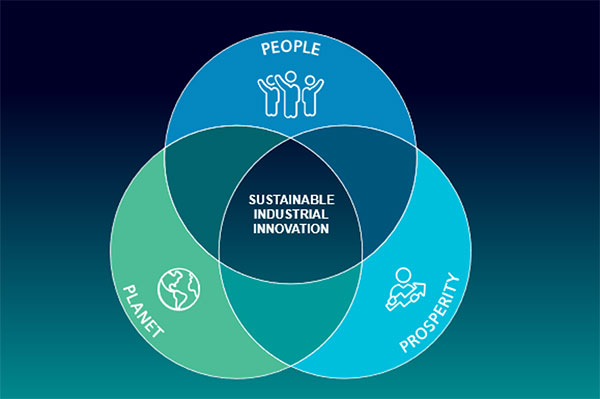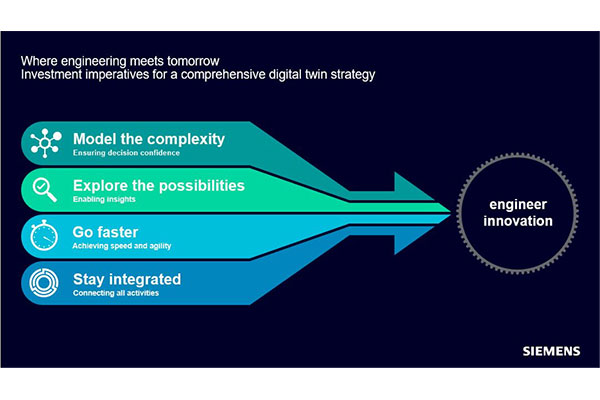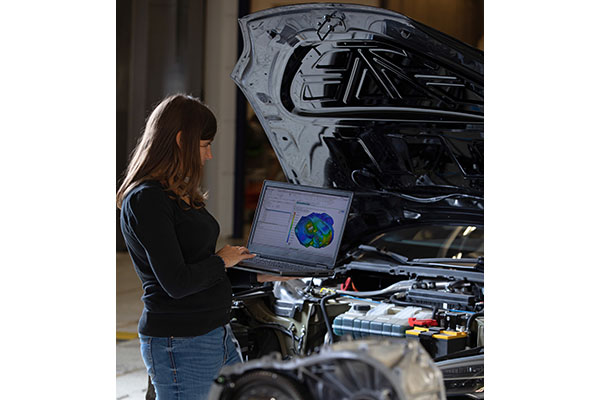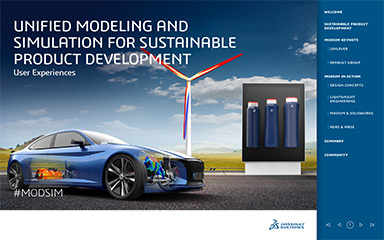Creating a Better World With Simulation and Test
The author asserts that the adoption of a comprehensive digital twin is the key enabler to sustainable industrial innovation success.

Siemens Xcelerator portfolio offers the integration between Capital, NX and Simcenter to enable such electro-mechanical co-design. Image courtesy of Siemens.
Latest News
June 3, 2022
Engineers are often called upon to design new products or improve existing ones with stringent specifications and requirements. In reality, they bring innovation into their products and processes that make the world a better place for us by improving the way people live, travel, connect or treat diseases.
Today, customers worldwide demand more personalized, lighter, and safer products, reduced emissions, improved energy efficiency, and extended operational performance. As a business leader, aside from looking at the bottom line, I am committed to help achieve sustainable industrial innovation to take better care of our planet and build a better future where anyone can turn today’s ideas into tomorrow’s products and experiences.

In a 2021 survey by TechClarity, 81% of respondents cited product quality and reliability as the most important factors to product success. Looking through the prism of sustainable industrial innovation, engineers face the tough challenge of designing reliable and sustainable products while managing complexity, reducing cost and shortening time to market. How does an engineer turn these seemingly contradictory requirements into opportunities?
I see the adoption of a comprehensive digital twin as the key enabler to sustainable industrial innovation success. By applying a digital twin, engineering teams can manage complexity with design decision trade-offs that result in product innovation. The combination of simulation and test is crucial in bringing the digital twin to life. I see this as the “beating heart” of such comprehensive digital twins. Digital simulation and test applications help harness design complexity and accelerate innovation over the entire lifecycle, delivering insights into the real-world performance of products and processes.
A comprehensive digital twin offers a flexible, open and scalable portfolio of predictive simulation and test applications at every step in the digital journey. It can help drive innovation into products by compressing time-to-market windows and detecting potential design flaws earlier in the design process.
Four key investment imperatives accelerate innovation through simulation and test solutions:
Model the Complexity
Solving complex industrial problems requires multidiscipline and multiphysics approaches to capture all of the complexities influencing product performance. Although engineers can now evaluate performance for a wide range of physics phenomena, each domain has historically required a specific set of software tools. User interfaces, processes, data files and vocabulary may be completely different and hinder collaboration. Therefore, full integration between multiple analysis tools is required to predict better how the engineer’s products will perform. A model-based approach that enables multi-domain simulation and verification is essential for developing today’s advanced products.
Explore the Possibilities
Modeling the complexity of today’s products is critical, but equally important is leveraging simulation and test to systematically and intelligently explore the design space to optimize performance and improve robustness. Alongside intelligent exploration, emerging technologies and methods such as AI and generative engineering are enabling a paradigm shift in how innovation is seeded. Using artificial intelligence (AI) and machine learning can generate hundreds of system architectures, which can be evaluated quickly to identify the most promising ones through generative engineering. Topology optimization is relevant for generating completely new designs with higher structural, fluid and thermal performances, and engineers can save on material and shorten processes when manufacturing those new shapes with additive manufacturing processes. Combining topology optimization and parametric exploration allows engineers to step beyond and optimize their best designs further.
Go Faster
The traditional pressures of time, cost and quality still apply even as complexity increases. Therefore, companies need to find a way to go faster no matter how complex their products. By leveraging models in development and extending their use in other phases of the product lifecycle, speed and agility is achieved. For example, reduced-order models boost the power of the digital twin for many applications. They enable faster predictions, are real-time capable of supporting virtual sensors and smart controllers and can be used as onboard digital twins to enhance system operations.

Artificial Intelligence (AI) is a ubiquitous technology today, and engineering is just scratching the surface of what is possible with it. For instance, it can help engineers by enabling faster setup of processes and predicting the next command they are likely to use, allowing novice and expert users to work with the same tool. Neural network models can accelerate early design performance predictions by a few orders of magnitude while capturing the trends of the changes. AI can turn digital twin models created during the design phase into executable digital twins that run real time on the edge device as smart virtual sensors. Here’s a great video showing virtual sensors in action—helping you measure the unmeasurable. In addition to enabling the closed-loop between physical performance and virtual response, the executable digital twin continuously predicts product performance and allows for real-time monitoring and decision-making to ensure operational excellence.

By taking advantage of cloud computing capacity, we can help users move even faster. Simulation and test tools in the cloud permit engineering teams to analyze larger problems with higher fidelity, conduct more complex simulations, run multiple design exploration studies concurrently and even adapt to changes in simulation on demand. The goal is to help engineering teams make better design decisions faster with engineering performance data provided by simulation and test solutions.
Stay Integrated
Connecting relevant activities in the product development process ensures that the right person can access the right information at the right time. Traditional CAD to CAE processes can be error-prone as they are disconnected, involving multiple users from various teams with different technical backgrounds. Too often, we still hear of instances where simulations are performed on obsolete versions of the design. For today’s complex products, an integrated toolset that combines design with multidisciplinary simulation allows engineering teams to stay aligned, work much faster and eliminate rework.
In our new digital era, it is crucial to test, validate and optimize real-world designs. Today, the role of physical testing is evolving. Test departments are feeling the effects of this evolution in their work, in volume and technical content. Now more than ever, innovative testing solutions are crucial to achieve maximum productivity.
Siemens is unique in offering a comprehensive portfolio of simulation and test. By combining Test with Simulation, the physical and virtual worlds interact intimately to complement each other in multiple scenarios, such as system-in-the-loop. When using Test for Simulation, test data is essentially used to build, validate, improve and drive simulation models. With Simulation for Test, simulation models expand test capabilities and improve and confirm test data.
As product complexity increases, simulation and test teams cannot afford to operate in isolation from the rest of the organization. Traceability and standardization of processes become critical. An investment in a managed environment can pay huge dividends.
Teamcenter Simulation is a simulation data and process management solution that is built for engineers.
Looking beyond the typical applications, one prime example of an extra layer of complexity is electrification and autonomous driving applications that increasingly require more complex wiring design. Staying integrated in this case means that teams designing wire harness and routing systems need to be aligned with teams performing system simulation, mechanical simulation and electromagnetic analysis to avoid interference. The Siemens Xcelerator portfolio offers the integration between Capital, NX and Simcenter to enable such electro-mechanical co-design.
At Siemens, I am driving the alignment of our investment priorities for Simcenter to address the needs of our customers and advance their sustainable industrial innovation for engineering a better tomorrow. The Xcelerator portfolio of software, services and low-code application development including Simcenter are driving digital transformation. By blurring the boundaries between industry domains, today’s leading engineering teams can apply Siemens Xcelerator solution to build their innovative products of tomorrow today.
About the Author

Jean-Claude Ercolanelli is Senior Vice President Simulation and Tests Solutions, and leads the Siemens Digital Industries Software Simulation and Test business segment, including serving as CEO for Siemens Industry Software NV.
Jean-Claude contributes to Siemens Digital Industries Software strategy to become the market and technology leader in Simulation and Analysis. Jean-Claude and his teams work closely with customers and the global sales and customer services to drive the execution of all necessary research, innovation and development activities to grow the products relevance, their scope and footprint in the industries.
Prior to Siemens, Jean-Claude joined CD-adapco in September 2005 to lead and manage the business growth of the CAD/PLM embedded solutions and since November 2006 he has been leading and managing the new STAR-CCM+ solution. He came to CD-adapco from ANSYS Inc. where he held a series of increasingly responsible roles in business development and product management for almost 6 years. Prior to that, he was at ESI Group for 8 years in product management, technical support, and consulting. His first position after university studies was to serve as a nuclear design engineer at Framatome for 3 years.
More Siemens Digital Industries Software Coverage
Subscribe to our FREE magazine, FREE email newsletters or both!
Latest News






